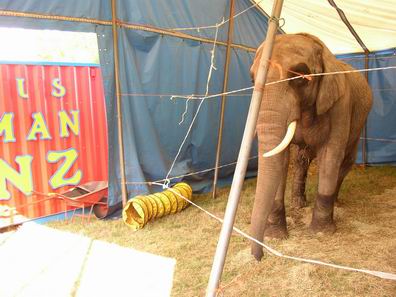Summary
In particular for wild species accommodation is a threat to their wellbeing, especially in the winter. Domestic animals are easier to accommodate. Training doesn’t necessarily has to create problems for their wellbeing, provided that they are taught by means of reward and provided that animals are used that don’t mind performing, like dogs. The display of tricks is a routine occupation for animals and this can only be seen as acceptable when an animal trainer respects the fact that animals sometimes don’t want to perform. Transport is an unclear issue, but although habituation may set in, most animals will experience transport in the initial stage as very stressful. | |

|
| | | |
Welfare issues The welfare issues for circus animals can roughly be divided into five aspects, namely: (1) accommodation, (2) transport, (3) training, (4) performance and (5) winter accommodation. To analyse these aspects on welfare-issues I will use the five liberties, as defined by the British animal welfare committee (Brambell 1965) as a framework. These liberties act as a guide-line for the European policy regarding intensively farmed animals to safeguard there welfare: - Freedom from thirst, hunger and malnutrition
- Freedom from discomfort due to environment
- Freedom from pain, injury and disease
- Freedom to express the normal behavioural characteristics peculiar to the species
- Freedom from fear and distress
It’s of interest here to distinguish between welfare-violation that can be prevented, for example not giving enough water (not giving enough water is a case of neglect) and unavoidable welfare-violation, like transport (the transportation of animals is inherent to the character of a circus). Unavoidable welfare violation can be a just cause to ban circuses. |
| | | |
Accommodation Domestic animals can in general be kept in sufficient large enclosures. (However, one can speculate whether a circus-horse should have the freedom to trot). In general speaking, wild animals are more dangerous and more unpredictable. Therefore there are stricter rules to their accommodation. Especially primates, bears, elephants and wild cats have to pay a high price for freedom of movement; this limits their normal behaviour (freedom 4). Also enrichment is usually not possible: a chimpanzee likes to climb, but circus-accommodation lacks climbing-facilities. Through such privation many circus-animals display stereotypical or apathetic behaviour, which can be considered as mental sorrow (freedom 5). |
| | | |
Transport As long as the duration of transport is within restricted range and the transport cages are adequate and comfortably equipped, some will argue that this is an acceptable aspect. Yet there is a lot of uncertainty as to whether circus animals experience transport as stressful (freedom 5). It is known that a once-only transport of farm animals is experienced as very stressful. Circus animals are often put on transport and it’s not known whether they get used to it. Each time the animals gets transported they have to get used to a new, for them hostile environment. |
| | | |
| Training On the subject of teaching acts on animals there’s big controversy. The circuses personal most often argue that they train their animals by successive approximation, which means the gradual learning of behaviour. A lion that has to jump through a burning hoop can for example first be taught to jump through a normal hoop. Subsequently the fire which he has to jump through will be made bigger so that the lion gradually gets used to the fire. Animal welfare people are inclined to believe that circus-animals only get trained by means of torture instruments. Though they are known, horrific cases, this should not be generalized. For example: some dog-owners teach their dogs tricks in a harsh manner, but most teach them with rewards. However it should be reminded that not all animals are so keen on learning tricks as dogs do. Cats are self-willed and will not often perform for a reward. Moreover, with big wild animals it’s of importance that an animal trainer creates a dominant position over his animals. Some degree of physical force seems to be unavoidable (freedom 3 & 5). Besides, some tricks are too difficult to learn for wild animals to do through the approximate approach. Training isn’t necessarily cruel as long as long as animals are used that enjoy learning to perform and this is done by means of reward and as long as the tricks do not cause them stress. |
| | | |
Performance It is sometimes stated that circuses are more animal friendly than zoo’s are, because they at least seek distraction during their performances. However, then it is assumed that they enjoy performing. That assumption is unfounded. The acts are in general routinely and compulsive, which can cause boredom and even aversion (freedom 5). Animals that display enjoyment in acting out tricks are exceptions to the rule. |
| | | |
Winter accommodation The condition of the winter accommodation is most often poorly. For domestic animals it’s quite possible to accommodate them in good conditioned housing. For a number of animals, in particularly wild animals, winter accommodation is problematic, because they can’t adjust to another climate. The animals are then kept in a small enclosure so the climatic-conditions can be controlled or they are kept outside where the climatic-conditions can not be controlled (freedom 2 & 4). |





0 komentarze
Prześlij komentarz